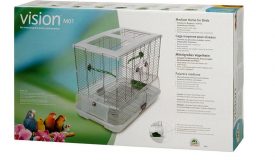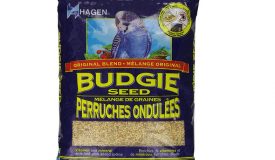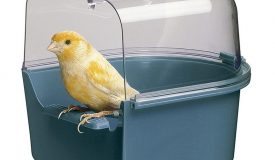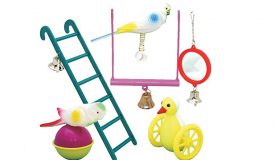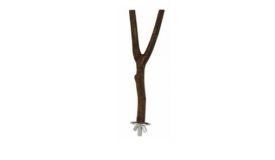Okay, so far we’ve looked at the cheapest and easiest pets to look after on a budget. Although entertaining, the top 4 pets chosen so far are not very ‘affectionate’. So if you want a pet that is a little more attentive and will even show you some affection, then small pet birds, such as budgies and cockatiels might be the answer.
3 Good birds to have as pets for childcare providers and children
There are many birds that can be kept as pets, although as a general rule pet birds are better for older children, rather than younger ones. This is because younger children can become over-excited and are not always as gentle when it comes to handling these delicate creatures and under 5s in particular, should not be allowed to handle them, as pet birds can also carry the risk of salmonella.
If you are concerned about young children becoming affected with salmonella, the risks can be easily reduced or eliminated, by keeping birds out of reach of young children, even if they are visible and also ensuring they regularly wash their hands – which is good practice anyway.
As budgies, cockatiels and other pet birds need little daily attention (even though they are a little more demanding than fish, frogs and cherry shrimp), they also make excellent pets.
These pets can also display emotions, so will need to give them some daily affection and sensitive consideration when children are not around.
Therefore the best 3 pet birds to keep in terms of cost and maintenance for a childcare provider are:
- A canary – These small, brightly colored, yellow birds will bring a smile to anyone’s day. They need the least attention out of all pet birds, because they are happy to sit in a cage all day without being taken out. Having said that they will need a big enough cage to fly around in, to give them exercise. They don’t need much interaction with humans and can amuse themselves by singing all day long. As they are so small, they don’t make much mess, so are easy to care for and clean (daily) and don’t cost much to feed. As far as birds go, they are not very noisy and their singing is the sweetest out of all the birds listed. They like to be alone, so one in a cage is fine without a mirror, although putting them with others wouldn’t harm them. Like all pet birds they can be tamed and trained, but this requires a lot of patience.
- Finches – These are similar to canaries in terms of care and cost, but these birds need a companion, hence you will need to buy them in pairs. For this reason, they are no.2. as this means, they will need bigger cages and extra space to fly around in which will add extra to the cost and maintenance.
- Budgies (also called parakeets or budgerigars) – are small parrots. They are as small as finches and canaries and should also be kept with a partner. However, being highly intelligent, they need more human interaction than canaries and finches. They will also need toys to keep them amused throughout the day. As they are so fidgety and energetic, they will need to be trained and then let out of their cage daily to have a fly around. They can also be trained to do tricks if you have the patience and can also be taught to talk! They can also be quite noisy, as they like to chatter to each other.
- Cockatiels – These descend from the cockatoo family and are a little bigger than the other birds mentioned, hence will need a little more room because of their size. They are also prefer to be kept as a pair because they are sociable birds. However, they are not as jittery or as chatty as their smaller counterparts and only vocalize in the morning and evenings. They spend most of their day, sitting and preening, hence have lower energy levels. They also like being handled and petted more than the others listed, making them ideal pets. These birds can also be taught to talk, but their speech will not be as clear as a descendant from the parrot family. These birds are also great whistlers. If you do have two, they will develop a pecking order, so will need separate perches, feeding bowls and so on in their cage. Cockatiels have delicate respiratory systems and can be very susceptible to strong smells such as air fresheners and smoke. These can even kill a cockatiel. Because of this, the cage should be kept away from these odors. They also do not like drafts, so keep them away from windows and doors and at night cover their cage to stop drafts.While male cockatiels whistle more, female birds are more affectionate. As they are so calm and submissive they can be bullied by even smaller birds like budgies, so this will need to be watched. Being highly intelligent, they will need lots of toys.
If you decide to keep pet birds, their cages will need to be cleaned every day. If your bird will spend most of its time in a cage then you should save up for a flight cage. If it will be out of the cage for a few hours each day then you can go for a smaller size.
They are intelligent animals so will need more daily stimulation and even human interaction. Alternatively, if you do not have much time to spend on them, being sociable, they will need interaction from a fellow bird.
However, birds together can be noisy, so if you do not want to hear noisy chatter all day, then limit how many you have.
If you would still like to keep one or two as a childcare provider, then you will need the following:
- A large enough cage for a canary to fly in – horizontal, rather than tall, or large enough for two or more to fly in if you have more than one bird.
Below are some minimum sizes, listing the height x width x length. Multiply these together to get the volume of the cage.
- The minimum size for a single budgie or small bird would be: 18x18x18 inches, which gives a volume of 5,832″ cubic inches or 46x46x46 cm = 97336 cubic cm
- Minimum size for 2 budgies or small birds would be: 30x18x18inches, which gives a volume of 9,720″ cubic inches or 77x46x46 cm = 162932 cubic cm
- Minimum size for 3 budgies or small birds would be: 32x18x20 inches, which gives a volume of 11,520″ cubic inches or 82x46x51 cm = 201756 cubic cm
Ensure the bars or wires are close enough together that the budgie cannot squeeze its head through. This will mean about 12mm or a half an inch spacing, anything larger and your small budgie could get stuck, and panic – which could be fatal.
- Minimum size for a cockatiel will be:20x20x24inches which gives a volume of 9,600″ cubic inches a medium to large cage, and taller. Ideally, the spacing of the bars on the cage should be 1/2″ or 5/8″, and as wide as ¾ of an inch.
- Lining for the tray – newspaper, kitchen tissue, other paper
- 2 Sponges
- Rubber gloves
- A bottle brush
- Kitchen towels to dry with
- Hand held vacuum cleaner
- Toys
- Feeding bottle
- Food trays – at least three, one for seed mix, water, and one for veggies etc. Placed away from perches so they can’t poop in them
- Bird bath
- Bird food
- Spray bottle
- Non-toxic disinfectant/ vinegar
Some the items you will require for your new pet can be found to the right of this page.
Also remember, if your bird gets sick, you may have to take them to the vet, which can add to your maintenance costs.
Some essentials you may require for your new pet
Click on the items to find out more.
Bird Cages
It’s important to choose the right cage for your bird/s. As small birds fly sideways rather than up and down, you should consider cages that are wider rather than taller….
Bird Food
Birds need a variety of different foods to stay fit and healthy. As well as providing them their own blend of bird seeds and nuts, also give them fresh fruit…
Cage Accessories
Like all pets, birds need an assortment of accessories to support their development and care. Ensure the accessories that are bought are going to fit inside your particular cage easily,…
Bird Toys
Birds are intelligent animals, particularly parakeets or budgies, which need a lot of stimulation. This can be provided in the form of toys and accessories that they can interact with…
Bird Perches
These are a great natural addition to your collection of accessories for your bird. Click on images

